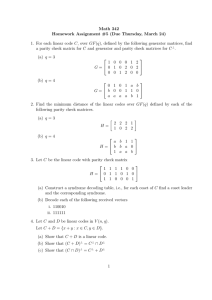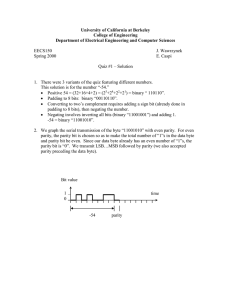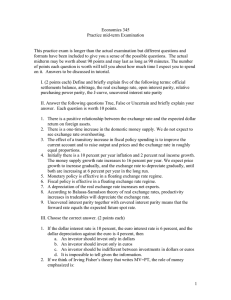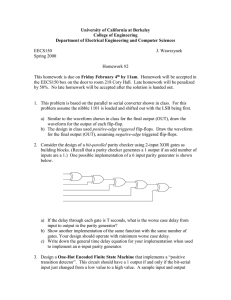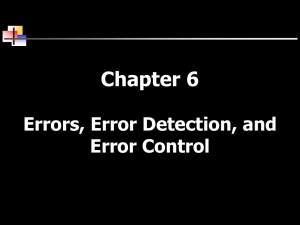Chapter Six Chapter Six - Errors, Error Detection, and Error Control 1
advertisement
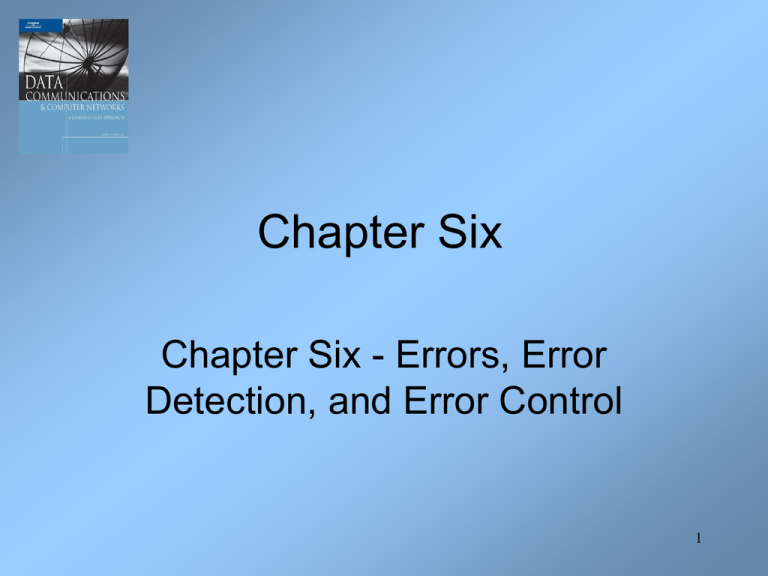
Chapter Six Chapter Six - Errors, Error Detection, and Error Control 1 Chapter Six - Errors, Error Detection, and Error Control Introduction Noise is always present. If a communications line experiences too much noise, the signal will be lost or corrupted. Communication systems should check for transmission errors. Once an error is detected, a system may perform some action. Some systems perform no error control, but simply let the data in error be discarded. 2 Chapter Six - Errors, Error Detection, and Error Control Noise and Errors – White Noise Also known as thermal or Gaussian noise Relatively constant and can be reduced. If white noise gets to strong, it can completely disrupt the signal. 3 Chapter Six - Errors, Error Detection, and Error Control 4 Chapter Six - Errors, Error Detection, and Error Control Noise and Errors – Impulse Noise One of the most disruptive forms of noise. Random spikes of power that can destroy one or more bits of information. Difficult to remove from an analog signal because it may be hard to distinguish from the original signal. Impulse noise can damage more bits if the bits are closer together (transmitted at a faster rate). 5 Chapter Six - Errors, Error Detection, and Error Control 6 Chapter Six - Errors, Error Detection, and Error Control 7 Chapter Six - Errors, Error Detection, and Error Control Noise and Errors - Crosstalk Unwanted coupling between two different signal paths. For example, hearing another conversation while talking on the telephone. Relatively constant and can be reduced with proper measures. 8 Chapter Six - Errors, Error Detection, and Error Control 9 Chapter Six - Errors, Error Detection, and Error Control Noise and Errors - Echo The reflective feedback of a transmitted signal as the signal moves through a medium. Most often occurs on coaxial cable. If echo bad enough, it could interfere with original signal. Relatively constant, and can be significantly reduced. 10 Chapter Six - Errors, Error Detection, and Error Control 11 Chapter Six - Errors, Error Detection, and Error Control Error Prevention To prevent errors from happening, several techniques may be applied: - Proper shielding of cables to reduce interference - Telephone line conditioning or equalization - Replacing older media and equipment with new, possibly digital components - Proper use of digital repeaters and analog amplifiers - Observe the stated capacities of the media 12 Chapter Six - Errors, Error Detection, and Error Control 13 Chapter Six - Errors, Error Detection, and Error Control Error Detection Despite the best prevention techniques, errors may still happen. To detect an error, something extra has to be added to the data/signal. This extra is an error detection code. Let’s examine two basic techniques for detecting errors: parity checking, and cyclic redundancy checksum. 14 Chapter Six - Errors, Error Detection, and Error Control Parity Checks Simple parity - If performing even parity, add a parity bit such that an even number of 1s are maintained. If performing odd parity, add a parity bit such that an odd number of 1s are maintained. For example, send 1001010 using even parity For example, send 1001011 using even parity 15 Chapter Six - Errors, Error Detection, and Error Control Parity Checks What happens if the character 10010101 is sent and the first two 0s accidentally become two 1s? Thus, the following character is received: 11110101. Will there be a parity error? Problem: Simple parity only detects odd numbers of bits in error. 16 Chapter Six - Errors, Error Detection, and Error Control Parity Checks Longitudinal parity adds a parity bit to each character then adds a row of parity bits after a block of characters. The row of parity bits is actually a parity bit for each “column” of characters. The row parity bits plus the column parity bits add a great amount of redundancy to a block of characters. 17 Chapter Six - Errors, Error Detection, and Error Control 18 Chapter Six - Errors, Error Detection, and Error Control 19 Chapter Six - Errors, Error Detection, and Error Control Parity Checks Both simple parity and longitudinal parity do not catch all errors. Simple parity only catches odd numbers of bit errors. Longitudinal parity is better at catching errors but requires too many check bits added to a block of data. We need a better error detection method. What about cyclic redundancy checksum? 20 Chapter Six - Errors, Error Detection, and Error Control Cyclic Redundancy Checksum The CRC error detection method treats the packet of data to be transmitted as a large polynomial. The transmitter takes the message polynomial and using polynomial arithmetic, divides it by a given generating polynomial. The quotient is discarded but the remainder is “attached” to the end of the message. 21 Chapter Six - Errors, Error Detection, and Error Control Cyclic Redundancy Checksum The message (with the remainder) is transmitted to the receiver. The receiver divides the message and remainder by the same generating polynomial. If a remainder not equal to zero results, there was an error during transmission. If a remainder of zero results, there was no error during transmission. 22 Chapter Six - Errors, Error Detection, and Error Control 23 Chapter Six - Errors, Error Detection, and Error Control Error Control Once an error is detected, what is the receiver going to do? 1. Do nothing 2. Return an error message to the transmitter 3. Fix the error with no further help from the transmitter 24 Chapter Six - Errors, Error Detection, and Error Control Error Control - Do Nothing Seems like a strange way to control errors but some lower layer protocols such as frame relay perform this type of error control. For example, if frame relay detects an error, it simply tosses the frame. No message is returned. Frame relay assumes a higher protocol (such as TCP/IP) will detect the tossed frame and ask for retransmission 25 Chapter Six - Errors, Error Detection, and Error Control Error Control - Return an Error Message Once an error is detected, an error message is returned to the transmitter Two basic forms: Stop-and-wait error control Sliding window error control 26 Chapter Six - Errors, Error Detection, and Error Control Stop-and-Wait Error Control Stop-and-wait is the simplest of the error control protocols. A transmitter sends a frame then stops and waits for an acknowledgment. If a positive acknowledgment (ACK) is received, the next frame is sent. If a negative acknowledgment (NAK) is received, the same frame is transmitted again. 27 Chapter Six - Errors, Error Detection, and Error Control 28 Chapter Six - Errors, Error Detection, and Error Control Sliding Window Error Control These techniques assume that multiple frames are in transmission at one time A sliding window protocol allows the transmitter to send up to the window size frames before receiving any acknowledgments. When a receiver does acknowledge receipt, the returned ACK contains the number of the frame expected next. 29 Chapter Six - Errors, Error Detection, and Error Control 30 Chapter Six - Errors, Error Detection, and Error Control Sliding Window Error Control Older sliding window protocols numbered each frame or packet that was transmitted More modern sliding window protocols number each byte within a frame Let’s look at an example in which the packets are numbered: 31 Chapter Six - Errors, Error Detection, and Error Control 32 Chapter Six - Errors, Error Detection, and Error Control This example shows each byte numbered 33 Chapter Six - Errors, Error Detection, and Error Control Sliding Window Error Control Notice that an ACK is not always sent after each frame is received. It is more efficient to wait for a few received frames before returning an ACK. How long should you wait until you return an ACK? 34 Chapter Six - Errors, Error Detection, and Error Control Sliding Window Error Control Using TCP/IP, there are some basic rules concerning ACKs Rule 1: If a receiver just received data and wants to send its own data, piggyback an ACK along with that data Rule 2: If a receiver has no data to return and has just ACKed the last packet, receiver waits 500 ms for another packet. If while waiting, another packet arrives, send the ACK immediately Rule 3: If a receiver has no data to return and has just ACKed the last packet, receiver waits 500 ms. No packet, send ACK 35 Chapter Six - Errors, Error Detection, and Error Control 36 Chapter Six - Errors, Error Detection, and Error Control Sliding Window Error Control What happens when a packet is lost? As shown in the next slide, if a frame is lost, the following frame will be “out of sequence”. The receiver will hold the out of sequence bytes in a buffer and request the sender to retransmit the missing frame. 37 Chapter Six - Errors, Error Detection, and Error Control 38 Chapter Six - Errors, Error Detection, and Error Control Sliding Window Error Control What happens when an ACK is lost? As shown in the next slide, if an ACK is lost, the sender will wait for the ACK to arrive and eventually time-out. When the time-out occurs, the sender will resend the last frame. 39 Chapter Six - Errors, Error Detection, and Error Control 40

